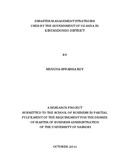| dc.description.abstract | Strategic Management has never been more crucial in a time like this when disasters are the norm all over the world. We have many organizations and institutions competing against each other, operating complimentarily and at times in opposition of each other trying to use the available limited resources to achieve their respective goals in addressing disasters. This has been further complicated by the turbulent and complex environment in which they operate and has created the need to constantly keep aligning themselves with their environment and adopting different strategies every time their environment changes in order to achieve their goals.
This study focuses on the use of appropriate disaster management strategies in the humanitarian sector not only to help the Organizations like Government and Relief Inter-agencies come up with Visions, Missions, Strategies and Objectives that they consider effective but also to identify how best they can serve other stakeholders, in particular the victims of disasters who are also beneficiaries of these efforts. To that effect, a survey will be undertaken that seeks to identify the strategies other African countries with a similar problem of landslides have put in place and how they go about addressing it in order to enrich the existing delivery of services to the affected. Disaster management strategies are influenced by factors such as, but not limited to; level of finances available, time constraint, availability of equipment and trained labour force, level of sensitization, availability of medicines, Non Food Items and Food Items, level of resilience of the community, use of contingency plans and so on, but at the end of the day disasters affect human beings with devastating ramifications. As seen in the literature review, many theories have been constructed to give advice on how Disasters can be dealt with, minimized, mitigated and in some cases avoided but the fact still remains disaster management is a complex activity because it involves a lot of dynamics and variables that cannot all be listed. Therefore with reference to the landslides that occurred in Bududa on 1 March 2010 resulting into internally displaced persons (IDPs) being relocated to Kiryandongo, and the response efforts that followed, the survey will include gathering of opinions of the victims and some Government officials on certain activities that were undertaken by Government and Relief Inter-agencies. | en |

